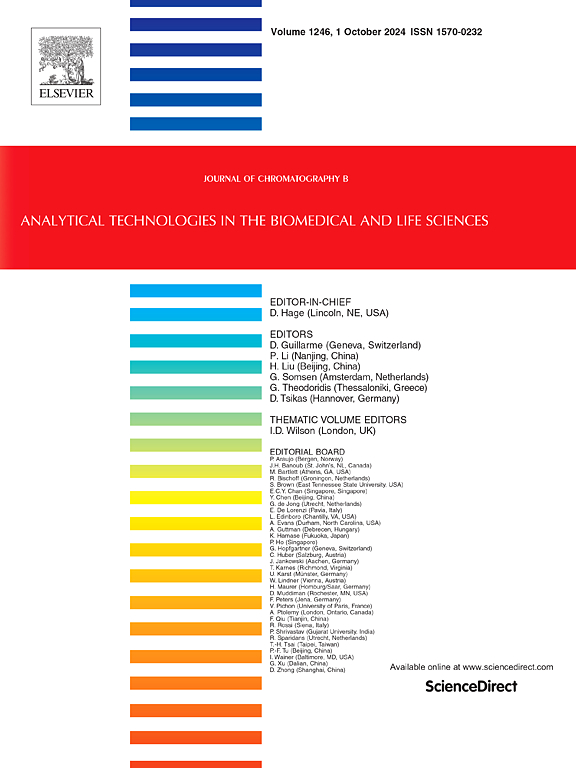Quantitative analysis of propylene glycol in saliva of e-cigarette users by gas chromatography-mass spectrometry
IF 2.8
3区 医学
Q2 BIOCHEMICAL RESEARCH METHODS
引用次数: 0
Abstract
A method was developed for the quantitation of propylene glycol in human saliva as a potentially useful biomarker for e-cigarette use. Saliva was collected from e-cigarette users, cigarette smokers, and non-users of any tobacco or nicotine product with approval from the University of Minnesota Human Research Protection Program Institutional Review Board. Two separate protocols, termed programmed and non-programmed, were used. In the programmed protocol, e-cigarette users (n = 20) and cigarette smokers (n = 20) brushed their teeth, waited 15 min, then used their product every 30 s for 5 min and collected a 2 mL saliva sample immediately after the last puff. In the non-programmed protocol, cigarette smokers (n = 30) and e-cigarette users (n = 21) came to the clinic and directly provided a saliva sample for analysis. Non-users (n = 29) of any nicotine or tobacco product served as controls. Propylene glycol in saliva was quantified by gas chromatography–mass spectrometry as its heptafluorobutyrate ester, using propylene glycol-d8 as the internal standard. Accuracy and precision of the assay were established. Levels of salivary propylene glycol (mean ± S.D.) were 269 ± 319 and 8.04 ± 8.22 μg/mL saliva in e-cigarette users and cigarette smokers, respectively, in the programmed protocol, while the corresponding levels in the non-programmed protocol were 4.94 ± 8.68 and 1.91 ± 1.99 μg/mL. These amounts were all significantly greater than those found in non-users of any tobacco or nicotine product (0.39 ± 0.32 μg/mL). This straightforward validated assay is expected to be useful in future clinical studies of e-cigarette use.
气相色谱-质谱联用法定量分析电子烟使用者唾液中的丙二醇
开发了一种定量人类唾液中丙二醇的方法,作为电子烟使用的潜在有用的生物标志物。经明尼苏达大学人类研究保护计划机构审查委员会批准,从电子烟使用者、吸烟者和不使用任何烟草或尼古丁产品的人身上收集唾液。使用了两种不同的方案,称为程序化和非程序化。在程序程序中,电子烟使用者(n = 20)和吸烟者(n = 20)刷牙,等待15分钟,然后每30秒使用他们的产品5分钟,并在最后一次吸完后立即收集2ml唾液样本。在非程序化方案中,吸烟者(n = 30)和电子烟使用者(n = 21)来到诊所直接提供唾液样本进行分析。不使用任何尼古丁或烟草制品的人(n = 29)作为对照。以丙二醇-d8为内标,采用气相色谱-质谱法定量测定唾液中的丙二醇为七氟丁酸酯。建立了该方法的准确度和精密度。电子烟使用者和吸烟者唾液丙二醇(平均±S.D.)水平在编程方案中分别为269±319和8.04±8.22 μg/mL,而在非编程方案中相应水平分别为4.94±8.68和1.91±1.99 μg/mL。这些含量均显著高于不使用任何烟草或尼古丁产品的人群(0.39±0.32 μg/mL)。这种简单有效的检测方法有望在未来电子烟使用的临床研究中发挥作用。
本文章由计算机程序翻译,如有差异,请以英文原文为准。
求助全文
约1分钟内获得全文
求助全文
来源期刊

Journal of Chromatography B
医学-分析化学
CiteScore
5.60
自引率
3.30%
发文量
306
审稿时长
44 days
期刊介绍:
The Journal of Chromatography B publishes papers on developments in separation science relevant to biology and biomedical research including both fundamental advances and applications. Analytical techniques which may be considered include the various facets of chromatography, electrophoresis and related methods, affinity and immunoaffinity-based methodologies, hyphenated and other multi-dimensional techniques, and microanalytical approaches. The journal also considers articles reporting developments in sample preparation, detection techniques including mass spectrometry, and data handling and analysis.
Developments related to preparative separations for the isolation and purification of components of biological systems may be published, including chromatographic and electrophoretic methods, affinity separations, field flow fractionation and other preparative approaches.
Applications to the analysis of biological systems and samples will be considered when the analytical science contains a significant element of novelty, e.g. a new approach to the separation of a compound, novel combination of analytical techniques, or significantly improved analytical performance.
 求助内容:
求助内容: 应助结果提醒方式:
应助结果提醒方式:


